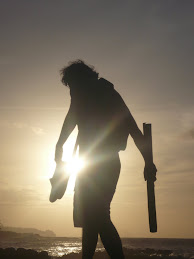Photo: Banana circle: functional and beautiful.
We stumbled across these simple banana circles at Laulima Farm in Kipahulu, on the road past Hana in the shadow of Haleakala (which I highly recommend checking out if you should ever find yourself wandering the magical road to Hana...).
It's a very simple design which can increase the tidiness, production & functionality of banana plants; by planting in a circle around a shallow pit filled with mulch, you can 'march' the bananas around the perimeter of the circle as the root corms send up new baby shoots. Sweet potato and other moisture-loving species like comfrey and mint can also be planted around the rim to increase yield and diversity in a concentrated area. Cacao was observed here, growing in the shade created between two banana circles.
Bananas are a very hungry plant, and will benefit from the extra concentration of nutrients the central mulch pit provides. Kitchen scraps from Laulima Farm's roadside stand were being dumped into this circle, and as you can see the plants were only too happy to take up all that excess nutrient and turn it into copious quantities of bananas.
The system can also work well for harvesting & processing greywater - turning greywater into bananas - so long as you are careful to esure that harsh chemical cleaning agents are avoided.
Rick Coleman of Southern Cross Permaculture Institute used banana pits in Central America, where subsistence farmers who were walking 2 hours each way to access their mountain grow plots had no toilet system, resulting in unhealthy (nasty!) runoff to the villages below.
Banana circles were dug upslope of their mountainside plots and filled with rocks & organic waste matter. These shallow versions of a pit latrine systems were an effective alternative to the practice of just going where and whenever the need arose, since typically only one or two people per day were using each banana pit.
In this simple example of Cycling Energy [Mollison] / Produce No Waste [Holmgren], a potentially toxic waste product is converted into a valuable nutrient source for an additional crop by asking the simple question:
- How can the waste products of one element in your system become an input for another?
Back to Laulima Farms, and there are 0 food miles here, because bananas are planted in such abundance throughout the property that they practically give them away. (As an aside, their banana bread is OFF-THE-HOOK (amazing), spelt flour is used more to bind the banana mash that is used to make the 'bread'. We muched on a couple slices while we waited for the customers ahead of us in line to blend their own smoothies...)
Photo: Human-powered smoothies!
Photo: Nitrogen-fixing Peanut grass and hardy Mint used as a wonderfully attractive groundcover.Photo: Food planted everywhere, as far as the eye can see at Laulima Farms.
Photo: Bamboo circle used to great effect as private seating area.. Photo: Bamboo construction used in Laulima's roadside stand.

